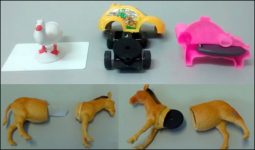
RFID technology helps children with Down syndrome to read
[ad_1]
Ecuadorian researcher and PhD Janio Jadán-Guerrero from the University of Costa Rica is developing an RFID system Kiteracy to help children with Down syndrome literate. He hopes that this system will be available to potential customers next year.
The system uses a TUI, a toy with a built-in high-frequency 13.56MHz tag, and an RFID reader plugged into a tablet or laptop. When the child picks up the toy near the reader, the reader will read the toy ID number, and then the Jadán-Guerrero software will obtain the item information. Then, the computer will display the word of the toy and play a sound. The software running on the server can also manage the children’s course progress data.

Jadán-Guerrero has a daughter with Down syndrome, so he hopes to develop a system to help children with learning disabilities learn to read. He hopes that with the help of this technology, children can learn the words of a specific object by themselves. He said: “The use of TUI can give children with Down syndrome a physical perception and help them to read.”
To this end, he studied many technologies including Microsoft Kinect and QR codes, but eventually found that their learning costs were too high. NFC technology is used for short-distance reading and writing, but it is also not applicable. The NFC tag needs to be directly attached to the reader to be read.
Then, Jadán-Guerrero tried a low-frequency 125kHz tag that complies with the EM4102 protocol and a high-frequency RFID tag that complies with the ISO 15693 standard. He found that the reading range of these tags is 10-15 cm, and these children only need to place them near the reader to be read.
Jadán-Guerrero said: “We want a technology with weak interference, and RFID seems to be the best choice.” He and colleagues from the University of Costa Rica, the Polytechnic University of Valencia, and the Polytechnic University of Madrid created some 3D printed objects and Place the HF RFID tag in it.
The team connected the reader to the notebook and developed a software to bind the tag ID number and corresponding item information, pictures, and pronunciation. They conducted a system test in a school for Down syndrome patients in Valencia, in which 12 children between 4-8 years old and 5 teachers participated in the experiment.
Researchers have used 3D printers to make various plastic toys, and each plastic toy has a space that can accommodate RFID tags. At the same time, the team also used a variety of materials (including: aluminum, glass, iron, cardboard, plastic, porcelain, rubber and wood) for testing. Jadán-Guerrero said: “We have found that some materials may reduce the performance of RFID. The orientation of the label will also affect the reading results. When the label is placed horizontally, the sensor works well; when placed vertically, the reading rate will decrease. In the end, the team used two readers to read at the same time to solve this problem.”

The researchers also attached the label to the card printed with the picture and tested it. Although they can be read normally, these children obviously prefer toys.
The results of the test make this system more suitable for children to use. Researchers learned from experiments that the color of the physical objects should be the same as the text displayed on the tablet, and that the system voice should preferably be a female voice. They also found that these children need affirmation, so they added some sound effects to the conditions.
In this test, the team used Tertium Technology’s IceKey HF reader and HF tags and inlays provided by Spanish company Coderco. The experiment conducted in Costa Rica used an LF 125 kHz reader with an ABS key fob.
Using this program, schools and other users can use their tablets to access the software on the Kiteracy website. The software can not only provide information based on the ID number of the RFID tag, but also check the children’s learning progress.

The system will provide aRFIDReader and 12 RFID toys. Jadán-Guerrero said that users can also purchase RFID tags separately, enter their own data and record themselves.
In the future, Jadán-Guerrero hopes to provide solutions in multiple languages worldwide. He said that he is currently looking for partners to help commercialize the project.
(Exclusive manuscript of rfid world network, please indicate the source author for reprinting!)
[ad_2]



